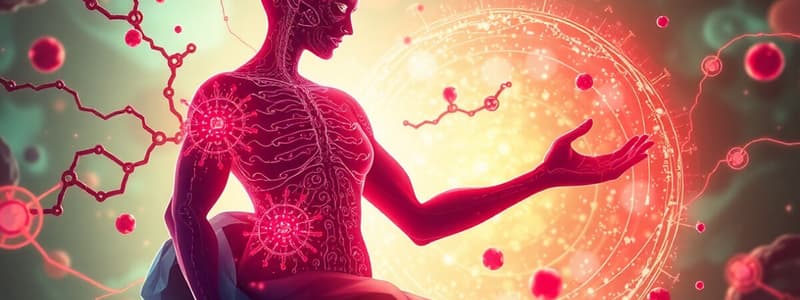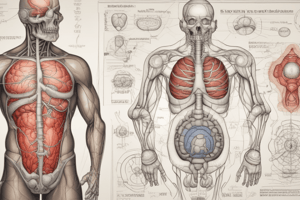Podcast
Questions and Answers
Why is plasma ferritin considered a good indicator of iron storage in the body?
Why is plasma ferritin considered a good indicator of iron storage in the body?
- It is derived from the storage pool of body iron and correlates with the overall iron stores. (correct)
- Its levels are inversely proportional to the iron concentration in the liver.
- It facilitates the transport of iron across the intestinal mucosal epithelium.
- It directly reflects the amount of iron circulating within red blood cells.
In cases of iron deficiency, how does the body attempt to maintain iron homeostasis?
In cases of iron deficiency, how does the body attempt to maintain iron homeostasis?
- By decreasing the synthesis of transferrin in the liver.
- By reducing iron loss through menstruation and lactation.
- By increasing the production of ferritin to store more iron.
- By increasing the synthesis of transferrin to enhance iron transport. (correct)
How does hemosiderin differ from ferritin in terms of iron storage and availability?
How does hemosiderin differ from ferritin in terms of iron storage and availability?
- Hemosiderin is a protein complex that can hold up to 4000 iron atoms, unlike ferritin.
- Hemosiderin stores iron in a more soluble form, making it readily available for the body's needs compared to ferritin.
- Hemosiderin is the main storage form of iron in tissues, whereas ferritin is primarily found in plasma.
- Hemosiderin releases iron more slowly and is less bioavailable than the iron stored in ferritin. (correct)
What is the primary role of divalent metal transporter 1 (DMT1) in iron absorption?
What is the primary role of divalent metal transporter 1 (DMT1) in iron absorption?
A patient presents with elevated plasma ferritin levels. Which of the following conditions is most likely contributing to this result, considering ferritin's role as an acute phase reactant?
A patient presents with elevated plasma ferritin levels. Which of the following conditions is most likely contributing to this result, considering ferritin's role as an acute phase reactant?
How does hepcidin regulate iron homeostasis in the body?
How does hepcidin regulate iron homeostasis in the body?
A patient with a chronic inflammatory condition develops anemia. Which of the following mechanisms best explains this occurrence?
A patient with a chronic inflammatory condition develops anemia. Which of the following mechanisms best explains this occurrence?
A female patient's lab results show low plasma ferritin and elevated transferrin levels. Which of the following is the most likely cause of these results?
A female patient's lab results show low plasma ferritin and elevated transferrin levels. Which of the following is the most likely cause of these results?
If dietary iron intake is chronically high, how does the body respond to maintain iron homeostasis?
If dietary iron intake is chronically high, how does the body respond to maintain iron homeostasis?
What effect do hypoxia and increased erythropoietin levels typically have on hepcidin secretion?
What effect do hypoxia and increased erythropoietin levels typically have on hepcidin secretion?
Why is iron bound to proteins such as transferrin and ferritin in the body?
Why is iron bound to proteins such as transferrin and ferritin in the body?
A patient with achlorhydria (absence of hydrochloric acid in gastric secretions) is likely to develop iron deficiency anemia because:
A patient with achlorhydria (absence of hydrochloric acid in gastric secretions) is likely to develop iron deficiency anemia because:
Which dietary modification would be MOST beneficial for an individual with iron deficiency anemia?
Which dietary modification would be MOST beneficial for an individual with iron deficiency anemia?
An individual who has undergone a significant hemorrhage is expected to have an increased rate of iron absorption. This is primarily due to:
An individual who has undergone a significant hemorrhage is expected to have an increased rate of iron absorption. This is primarily due to:
If a patient is prescribed a proton pump inhibitor (PPI) for long-term management of acid reflux, what potential impact on iron metabolism should be considered?
If a patient is prescribed a proton pump inhibitor (PPI) for long-term management of acid reflux, what potential impact on iron metabolism should be considered?
Flashcards
Iron
Iron
An essential element present mainly in heme; important for compounds like hemoglobin and iron storage proteins.
Iron Deficiency Anemia
Iron Deficiency Anemia
Microcytic hypochromic anemia resulting from insufficient iron to produce enough healthy red blood cells.
Hemochromatosis
Hemochromatosis
Iron overload causing iron accumulation in the body, potentially damaging organs.
Transferrin
Transferrin
Signup and view all the flashcards
Ferritin
Ferritin
Signup and view all the flashcards
DMT1 Function
DMT1 Function
Signup and view all the flashcards
HCP1 Function
HCP1 Function
Signup and view all the flashcards
Ferroportin Function
Ferroportin Function
Signup and view all the flashcards
Transferrin Function
Transferrin Function
Signup and view all the flashcards
Hepcidin's Role
Hepcidin's Role
Signup and view all the flashcards
Hemosiderin
Hemosiderin
Signup and view all the flashcards
Transferrin (TIBC)
Transferrin (TIBC)
Signup and view all the flashcards
Plasma Ferritin
Plasma Ferritin
Signup and view all the flashcards
Iron in Blood
Iron in Blood
Signup and view all the flashcards
Study Notes
- Iron is an essential element found mainly in heme and iron storage proteins like ferritin and hemosiderin.
- Adult humans have about 3-5 grams of iron in their bodies.
Iron Metabolism - Clinical Significance
- Iron deficiency can lead to microcytic hypochromic anemia, also known as iron deficiency anemia.
- Overdose of iron can cause haemosiderosis, also known as iron overload or haemochromatosis.
Recommended Daily Iron Intake (RDA)
- Adults: 10 mg/day.
- Females under 50 and during lactation: up to 15 mg/day.
- Pregnant women: up to 30 mg/day.
Dietary Sources of Iron
- Animal sources are liver, spleen, and meat.
- Plant sources are molasses, dates, leafy greens, legumes, and whole cereals.
Distribution of Iron
- Total iron in the body is 3-5 grams, available in functional and non-functional forms.
- Functional forms (75%) include hemoglobin (67%), myoglobin (7.5%), and enzymes of the ETC (0.5%) like cytochromes.
- Non-functional forms (25%) are bound to proteins (non-heme) for transport and storage because free iron is toxic.
- Transferrin transports iron in the blood (0.1%).
- Ferritin & hemosiderin store iron in tissues.
Iron Absorption
- Iron absorption occurs mainly in the duodenum.
- Only ferrous (Fe++) form, also "reduced form", is absorbed; ferric (Fe+++) form is not.
- Iron exists in two dietary forms: heme iron (animal, 10%) and non-heme iron (plant, 90%).
- Heme iron from meat is more readily absorbed.
- Normal iron absorption rate ranges from 2% to 20% (10%).
Factors Affecting Iron Absorption
- The amount of iron ingested has a direct correlation to absorption
- Body requirements will increase erythropoiesis, enhancing iron absorption.
- Vitamin C facilitates the reduction of ferric to ferrous form, aiding absorption.
- Gastric HCl helps liberate iron from food and converts ferric to ferrous form.
- Achlorhydria and proton pump inhibitors can cause iron deficiency.
Mechanism of Iron Absorption
- Iron is absorbed by enterocytes of intestinal mucosa, mainly in the duodenum.
- Ferric iron not reduced in the stomach is reduced to ferrous in the duodenum by reductase enzyme.
- Divalent metal transporter 1 (DMT1) transports Fe++ into the enterocyte.
- Heme carrier protein (HCP1) transports heme into the enterocytes.
- Without demand, iron is stored as ferritin inside the enterocytes.
- With +++ demand, iron is transported to the baso-lateral border via ferroportin, then into the blood.
- Iron (Fe3+) in plasma is transported by transferrin (a plasma protein), which is normally 35% saturated with iron.
- Transferrin delivers iron to bone marrow, liver, and muscle cells having receptors for transferrin on their surface.
Iron Homeostasis
- Iron deficiency causes microcytic anemia.
- Iron overload causes hemosiderosis.
- The human body lacks mechanisms for regulating iron excretion, relying on absorption mechanisms to maintain normal blood iron levels.
Factors Affecting Iron Absorption
- Dietary iron: Increased iron intake reduces DMT1 numbers, decreasing absorption.
- Hepcidin is a liver-secreted 25-amino acid hormone and a major regulator of intestinal iron absorption and lowers iron plasma level.
Hepcidin Actions
- Hepcidin binds to ferroportin in enterocytes, macrophages, and liver cells, leading to degradation of ferroportin molecules.
- This results in inhibition of intestinal iron absorption, inhibition of recycled iron release from macrophages, and inhibition of iron release from liver and other storage sites.
Factors Affecting Hepcidin Secretion
- Hypoxia and erythropoietin decrease hepcidin secretion.
- Iron loading increases hepcidin, while iron deficiency decreases its secretion.
- Inflammation increases hepcidin secretion, potentially causing anemia.
Iron Excretion
- Iron is a one-way element, and the regulation of homeostasis occurs primarily at the absorption level.
- Total daily loss is about 1 mg.
- Fecal iron (90%) consists mainly of unabsorbed iron and desquamated intestinal cells.
- Urinary loss is negligible, with some loss (5-10%) occurring through sweating and shedding of skin.
- Menstruation and milk lead to iron loss, 15–30 mg per period and 0.5 - 1mg per day of lactation.
- Any type of bleeding will cause a loss of iron from the body.
- Menstrual flow is the major cause for loss of iron in women
Iron Storage Forms
- Ferritin is the main storage form in tissues.
- Ferritin is found in the liver, spleen, bone marrow, and intestinal mucosal epithelium.
- Ferritin is a globular protein complex (apoferritin) in which iron atoms pack as ferric.
- A ferritin molecule can hold up to 4000 atoms, but its binding sites are only about 23% saturated.
- Plasma contains very low concentrations of ferritin (20–250 mg/L) a good index of iron storage.
- Plasma ferritin levels correlate with body iron stores, decreasing in iron deficiency anemia and increasing in iron overload.
- Ferritin is a positive acute phase reactant, elevated in inflammatory diseases.
- Hemosiderin: it is more insoluble than ferritin, and releases iron more slowly in cases of excess iron.
Iron Transport in the Blood
- Transferrin transports iron in the blood and carries 1-2 ferric atoms.
- Transferrin, also known as Total Iron Binding Capacity (TIBC) in the liver
- Transferrin is 30% saturated with iron, described by Percent Saturation
- Its production increases in iron deficiency and decreases in iron overload.
- It acts as a negative acute phase reactant, declining during inflammatory conditions.
Iron in Blood Exists
- Inside hemoglobin of RBCs.
- In the plasma as transferrin and plasma ferritin.
Laboratory Assessments of Iron Status
- Plasma ferritin is the first parameter measured, closely tied to body iron stores; low indicates depletion, high indicates overdose (hemosiderosis).
- Also acts as a positive acute phase reactant, and is elevated during inflammatory disorders.
- Plasma Transferrin (TIBC): Transferrin synthesis increases in iron deficiency and falls in cases of iron overload.
- Percent Saturation (Serum Iron/TIBC) normally ranges from 30-40%. Reduced levels can be seen with Iron Deficiency (less than 30%)
- Plasma decreases with with an increased TIBC, increased levels are present in Iron Overdose_ (up to 100%) with a decreased TIBC.
Plasma Iron
- Last parameter to be measured for its limited diagnostic value because of fluctuations
- Affected widely by outside factors like diurnal rhythm, menstruation, oral contraceptive pills intake, pregnancy, etc.
- Plasma Iron alterations are noticed late that is associated with inadequate iron stores (reduced); while elevated in iron overdose.
- Plasma iron can also be altered in cases not associated a direct influence or affect with iron, such as infections and inflammation, even when iron stores are largely uneffected.
Iron Deficiency Anemia (IDA)
- Most common nutrient deficiency.
- Caused deficient iron intake, increased demand, decreased absorption or when there is excessive loss of iron.
Deficient Iron Intake
- Occurs as a result of a diet poor in iron over a long duration.
Increased Demand of Iron
- Seen as a cause during pregnancy, lactation & menstruation.
Decreased Absorption of Iron
- Is a consequence of conditions such subtotal gastrectomy, Achlorhydria, or the use of Proton pump inhibitors.
Excessive Loss of Iron
- Caused during chronic bleeding, such as from Hookworm infection, Nephroticsyndrome (transferrin loss in urine).
Lab Investigations for Iron Deficiency
- Low Plasma Ferritin (EARLY)
- Increase Transferrin (or TIBC)
- Low TIBC Saturation - Serum Iron/transferrin, less than 30%.
- Low Plasma Iron - measured Late
- Anemia, that is finally evident by lab investigation (specifically microcytic, hypochromic anemia).
Iron Overload (Iron Toxicity)
- Hemosiderosis, results in +++ hemosiderin (ferritin deposits) intissues
- Iron accumulation, can result in pigmentation of skin, diabetes, liver cirrhosis and hepatic carcinoma.
Treatment for Iron Overload
- Can be treated by venesection (removal of 500ml blood / time)
- Repeated blood transfusion in hemolytic anemia cases- use iron-chelating substances.
Laboratory Investigations of Iron Overload
- High Plasma Ferritin (EARLY)
- Low or Normal Transferrin (or TIBC)
- High Percent Saturation (Early)
- High as a indication of Plasma Iron (Late)
Studying That Suits You
Use AI to generate personalized quizzes and flashcards to suit your learning preferences.




